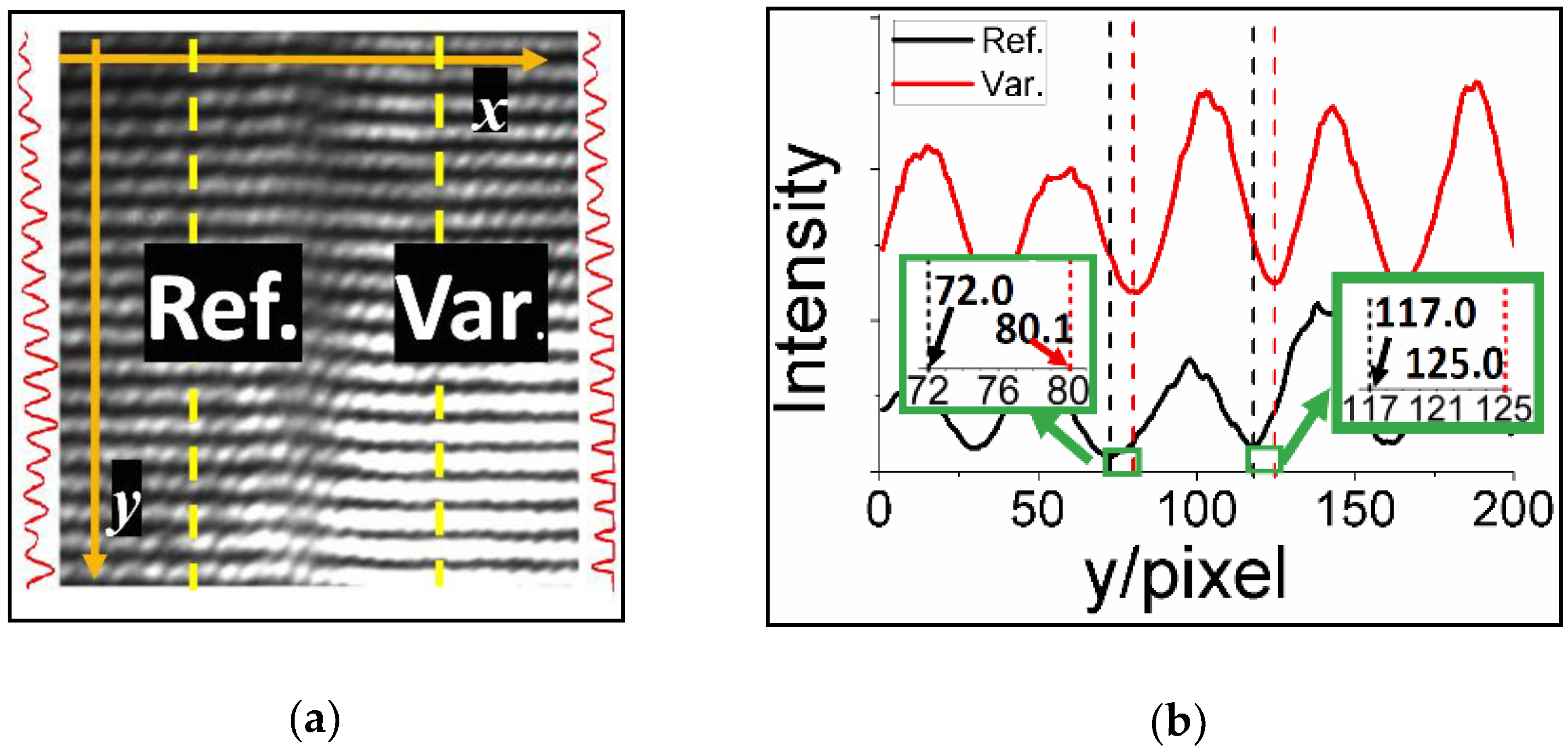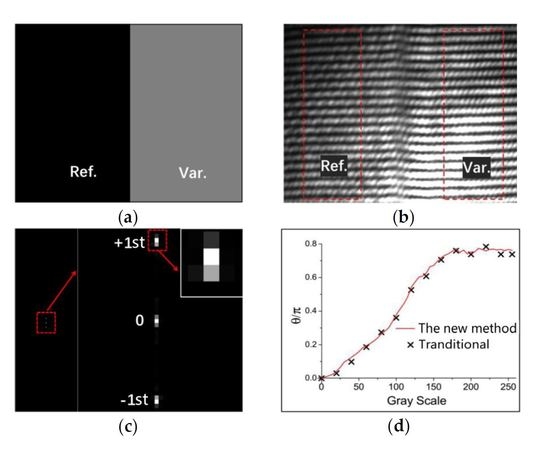Characterization of Spatial Light Modulator Based on the Phase in Fourier Domain of the Hologram and Its Applications in Coherent Imaging
Abstract
:Featured Application
Abstract
1. Introduction
2. Analysis and Methods
- Step 1: Divide the image loading on the SLM into two parts. One part (named the reference part) has a constant gray scale of 0. The other one (named the variable part) has a gray scale varying from 0 to 255 (for the 8-bit-gray-scale SLM) during the experiment.
- Step 2: There are then two sets of interfered patterns in the holograms accordingly. An area with the same size is selected from each for Fourier transform. In the practice, the areas are far from the borders of the two patterns to avoid the influence of the diffraction in the border.
- Step 3: Subtract phase of the point with the highest intensity in +1st order spot for the reference part from for the variable part. Then difference is phase variation θ.
3. Results
3.1. Simulation Results
3.2. Experimental Methods and Results
3.3. Applications in Coherent Imaging
4. Discussion and Conclusions
5. Patents
Author Contributions
Funding
Acknowledgments
Conflicts of Interest
References
- Ren, Z.; Chen, N.; Lam, E.Y. Extended focused imaging and depth map reconstruction in optical scanning holography. Appl. Opt. 2016, 55, 1040–1047. [Google Scholar] [CrossRef] [PubMed]
- Qu, X.; Song, Y.; Jin, Y.; Li, Z.; Wang, X.; Guo, Z.; Ji, Y.; He, A. 3D SAPIV particle field reconstruction method based on adaptive threshold. Appl. Opt. 2018, 57, 1622–1633. [Google Scholar] [CrossRef] [PubMed]
- Pourvais, Y.; Asgari, P.; Abdollahi, P.; Khamedi, R.; Moradi, A.-R. Microstructural surface characterization of stainless and plain carbon steel using digital holographic microscopy. J. Opt. Soc. Am. B 2017, 34. [Google Scholar] [CrossRef]
- Wang, H.; Dong, Z.; Wang, S.; Lou, Y. Comparison of the refocus criteria for the phase, amplitude, and mixed objects in digital holography. Opt. Eng. 2018, 57, 054111. [Google Scholar] [CrossRef]
- McReynolds, N.; Cooke, F.G.M.; Chen, M.; Powis, S.J.; Dholakia, K. Multimodal discrimination of immune cells using a combination of Raman spectroscopy and digital holographic microscopy. Sci. Rep. 2017, 7, 43631. [Google Scholar] [CrossRef] [PubMed] [Green Version]
- Yi, F.; Moon, I.; Javidi, B. Automate red blood cells extraction from holographic images using fully convolutional neural networks. Biomed. Opt. Express 2017, 8, 4466–4479. [Google Scholar] [CrossRef] [PubMed]
- Merola, F.; Memmolo, P.; Miccio, L.; Savoia, R.; Mugnano, M.; Fontana, A.; D’Ippolito, G.; Sardo, A.; Iolascon, A.; Gambale, A.; et al. Tomographic flow cytometry by digital holography. Light Sci. Appl. 2017, 6, e16241. [Google Scholar] [CrossRef]
- Dohet-Eraly, J.; Yourassowsky, C.; Dubois, F. Fast numerical autofocus of multispectral complex fields in digital holographic microscopy with a criterion based on the phase in the Fourier domain. Opt. Lett. 2016, 41, 4071–4074. [Google Scholar] [CrossRef] [PubMed]
- Wang, C.; Su, Y.; Wang, J.; Zhang, C.; Zhang, Z.; Li, J. Method for holographic femtosecond laser parallel processing using digital blazed grating and the divergent spherical wave. Opt. Eng. 2015, 54, 016109. [Google Scholar] [CrossRef]
- Collings, N.; Christmas, J.L.; Masiyano, D.; Crossland, W.A. Real-time phase-only spatial light modulator for 2D holographic display. J. Disp. Technol. 2015, 11, 278–284. [Google Scholar] [CrossRef]
- Harm, W.; Jesacher, A.; Thalhammer, G.; Bernet, S.; Ritsch-Marte, M. How to use a phase-only spatial light modulator as a color display. Opt. Lett. 2015, 40, 581–584. [Google Scholar] [CrossRef] [PubMed]
- Xu, P.; Hong, C.; Sun, Z.; Han, F.; Cheng, G. Integrated zigzag Vander Lugt correlators incorporating an optimal trade-off synthetic discriminant filter for invariant pattern recognition. Opt. Commun. 2014, 315, 97–102. [Google Scholar] [CrossRef]
- Zhan, Q. Cylindrical vector beams: From mathematical concepts to applications. Adv. Opt. Photonics 2009, 1, 1–57. [Google Scholar] [CrossRef]
- Maluenda, D.; Juvells, I.; Martinez-Herrero, R.; Carnicer, A. Reconfigurable beams with arbitrary polarization and shape distributions at a given plane. Opt. Express 2013, 21, 5424–5431. [Google Scholar] [CrossRef] [PubMed]
- Maluenda, D.; Carnicer, A.; Martinez-Herrero, R.; Juvells, I.; Javidi, B. Optical encryption using photon-counting polarimetric imaging. Opt. Express 2015, 23, 655–666. [Google Scholar] [CrossRef] [PubMed]
- Bergeron, A.; Gauvin, J.; Gagnon, F.; Gingras, D.; Arsenault, H.H.; Doucet, M. Phase calibration and applications of a liquid-crystal spatial light modulator. Appl. Opt. 1995, 34, 5133–5139. [Google Scholar] [CrossRef] [PubMed]
- Dou, R.; Giles, M.K. Simple technique for measuring the phase property of a twisted nematic liquid crystal television. Opt. Eng. 1996, 35, 808–812. [Google Scholar] [CrossRef]
- Reichelt, S. Spatially resolved phase-response calibration of liquid-crystal-based spatial light modulators. Appl. Opt. 2013, 52, 2610–2618. [Google Scholar] [CrossRef] [PubMed]
- Matín-Badosa, E.; Carnier, A.; Juvells, I.; Vallmitjana, S. Complex modulation characterization of ligquid crystal devices by interferometric data correlation. Meas. Sci. Technol. 1997, 8, 764–772. [Google Scholar] [CrossRef]
- Otón, J.; Ambs, P.; Millán, M.S.; Pérez-Cabré, E. Multipoint phase calibration for improved compensation of inherent wavefront distortion in parallel aligned liquid crystal on silicon displays. Appl. Opt. 2007, 46, 5667–5679. [Google Scholar] [CrossRef]
- Bondareva, A.P.; Cheremkhin, P.A.; Evtikhiev, N.N.; Krasnov, V.V.; Starikov, R.S.; Starikov, S.N. Measurement of characteristics and phase modulation accuracy increase of LC SLM “HoloEye PLUTO VIS”. J. Phys. Conf. Ser. 2014, 536, 012011. [Google Scholar] [CrossRef]
- Zhang, Z.; Lu, G.; Yu, F.T.S. Simple method for measuring phase modulation in liquid crystal televisions. Opt. Eng. 1994, 33, 3018–3022. [Google Scholar] [CrossRef]
- McDermott, S.; Li, P.; Williams, G.; Maiden, A. Characterizing a spatial light modulator using ptychography. Opt. Lett. 2017, 42, 371–374. [Google Scholar] [CrossRef] [PubMed]
- Dev, K.; Singh, V.R.; Asundi, A. Full-field phase modulation characterization of liquid-crystal spatial light modulator using digital holography. Appl. Opt. 2015, 50, 1593–1600. [Google Scholar] [CrossRef] [PubMed]
- Lv, N. Fourier Optics, 2nd ed.; China Machine Press: Beijing, China, 2006; pp. 31–39. ISBN 978-7-111-18480-5. [Google Scholar]
- Zhang, F.; Pedrini, G.; Osten, W. Phase retrieval of arbitrary complex-valued fields through aperture-plane modulation. Phys. Rev. A 2007, 75, 043805. [Google Scholar] [CrossRef]
- Kohler, C.; Zhang, F.; Osten, W. Characterization of a spatial light modulator and its application in phase retrieval. Appl. Opt. 2009, 48, 4003–4008. [Google Scholar] [CrossRef] [PubMed]






© 2018 by the authors. Licensee MDPI, Basel, Switzerland. This article is an open access article distributed under the terms and conditions of the Creative Commons Attribution (CC BY) license (http://creativecommons.org/licenses/by/4.0/).
Share and Cite
Wang, H.; Dong, Z.; Fan, F.; Feng, Y.; Lou, Y.; Jiang, X. Characterization of Spatial Light Modulator Based on the Phase in Fourier Domain of the Hologram and Its Applications in Coherent Imaging. Appl. Sci. 2018, 8, 1146. https://doi.org/10.3390/app8071146
Wang H, Dong Z, Fan F, Feng Y, Lou Y, Jiang X. Characterization of Spatial Light Modulator Based on the Phase in Fourier Domain of the Hologram and Its Applications in Coherent Imaging. Applied Sciences. 2018; 8(7):1146. https://doi.org/10.3390/app8071146
Chicago/Turabian StyleWang, Huaying, Zhao Dong, Feng Fan, Yunpeng Feng, Yuli Lou, and Xianan Jiang. 2018. "Characterization of Spatial Light Modulator Based on the Phase in Fourier Domain of the Hologram and Its Applications in Coherent Imaging" Applied Sciences 8, no. 7: 1146. https://doi.org/10.3390/app8071146
APA StyleWang, H., Dong, Z., Fan, F., Feng, Y., Lou, Y., & Jiang, X. (2018). Characterization of Spatial Light Modulator Based on the Phase in Fourier Domain of the Hologram and Its Applications in Coherent Imaging. Applied Sciences, 8(7), 1146. https://doi.org/10.3390/app8071146





